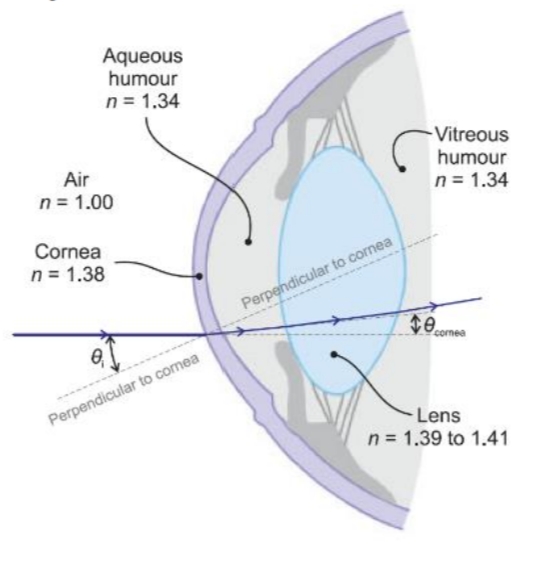10. The ability of your eyes to focus is impaired when you attempt to look around underwater (if you are not wearing a pair of swimming goggles). (a) Using Figure from Problem 9, calculate by what angle (Ocornea) is the incident beam of light deviated as it passes from water to the cornea if the incident angle is 0; = 23.6°? (c) How do you think why people can not see clearly Perpendicular to comes Lens n= 1,39 to 1.41 in water? Aqueous humour n = 1.34 Vitreous humour n= 1.34 Air n = 1.00 Cornea n = 1.38 Perpendicular to cornea conea Perpendicular to comea Lens n = 1.39 to 1.41
10. The ability of your eyes to focus is impaired when you attempt to look around underwater (if you are not wearing a pair of swimming goggles). (a) Using Figure from Problem 9, calculate by what angle (Ocornea) is the incident beam of light deviated as it passes from water to the cornea if the incident angle is 0; = 23.6°? (c) How do you think why people can not see clearly Perpendicular to comes Lens n= 1,39 to 1.41 in water? Aqueous humour n = 1.34 Vitreous humour n= 1.34 Air n = 1.00 Cornea n = 1.38 Perpendicular to cornea conea Perpendicular to comea Lens n = 1.39 to 1.41
College Physics
1st Edition
ISBN:9781938168000
Author:Paul Peter Urone, Roger Hinrichs
Publisher:Paul Peter Urone, Roger Hinrichs
Chapter25: Geometric Optics
Section: Chapter Questions
Problem 12PE: (a) Using information in Figure 25.53, find the height of the instructor's head above the water,...
Related questions
Question

Transcribed Image Text:10. The ability of your eyes to focus is impaired when you attempt
to look around underwater (if you are not wearing a pair of swimming
goggles). (a) Using Figure from Problem 9, calculate by what angle
(Ocornea) is the incident beam of light deviated as it passes from water
to the cornea if the incident angle is 0; = 23.6°? (c) How do you think why people can not see clearly
Perpendicular to comes
Lens
n= 1,39 to 1.41
in water?

Transcribed Image Text:Aqueous
humour
n = 1.34
Vitreous
humour
n= 1.34
Air
n = 1.00
Cornea
n = 1.38
Perpendicular to cornea
conea
Perpendicular to comea
Lens
n = 1.39 to 1.41
Expert Solution
This question has been solved!
Explore an expertly crafted, step-by-step solution for a thorough understanding of key concepts.
This is a popular solution!
Trending now
This is a popular solution!
Step by step
Solved in 3 steps with 3 images

Recommended textbooks for you

College Physics
Physics
ISBN:
9781938168000
Author:
Paul Peter Urone, Roger Hinrichs
Publisher:
OpenStax College

University Physics Volume 3
Physics
ISBN:
9781938168185
Author:
William Moebs, Jeff Sanny
Publisher:
OpenStax


College Physics
Physics
ISBN:
9781938168000
Author:
Paul Peter Urone, Roger Hinrichs
Publisher:
OpenStax College

University Physics Volume 3
Physics
ISBN:
9781938168185
Author:
William Moebs, Jeff Sanny
Publisher:
OpenStax


College Physics
Physics
ISBN:
9781285737027
Author:
Raymond A. Serway, Chris Vuille
Publisher:
Cengage Learning

College Physics
Physics
ISBN:
9781305952300
Author:
Raymond A. Serway, Chris Vuille
Publisher:
Cengage Learning

Physics for Scientists and Engineers, Technology …
Physics
ISBN:
9781305116399
Author:
Raymond A. Serway, John W. Jewett
Publisher:
Cengage Learning